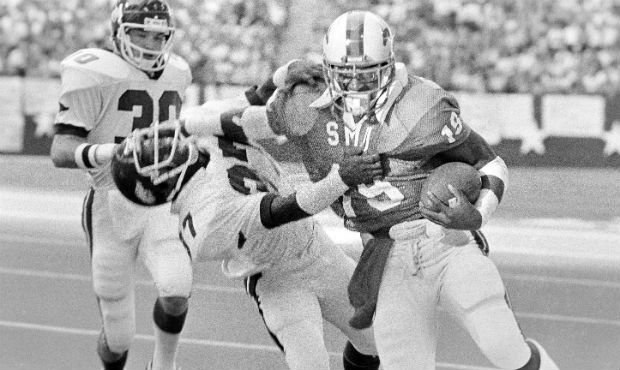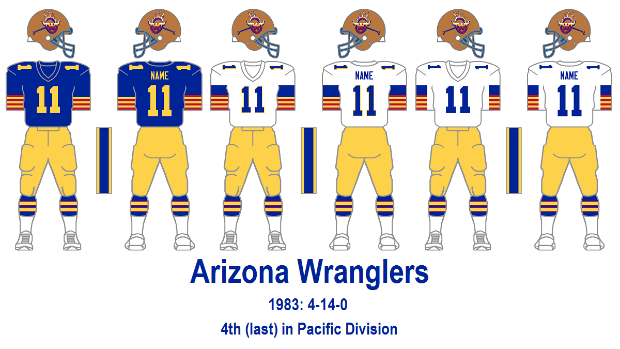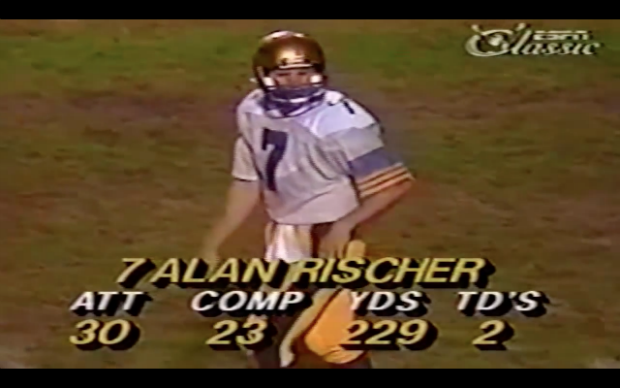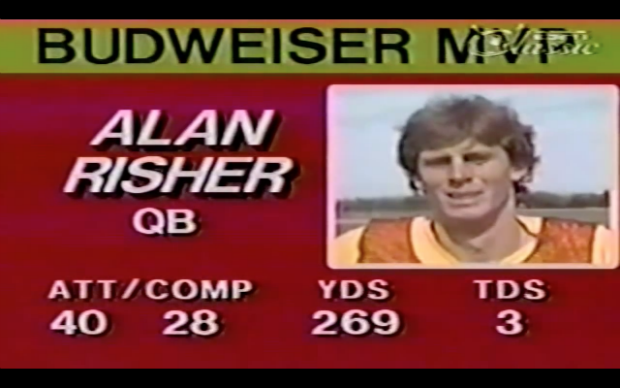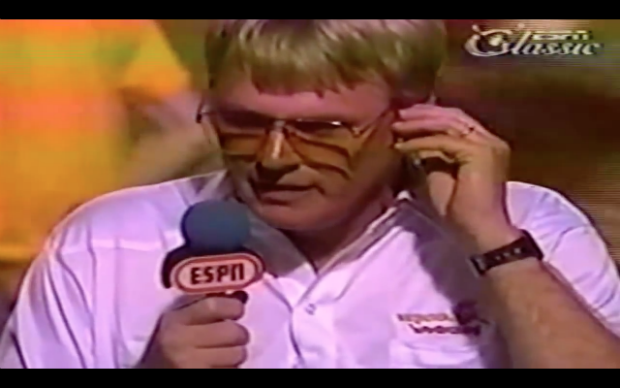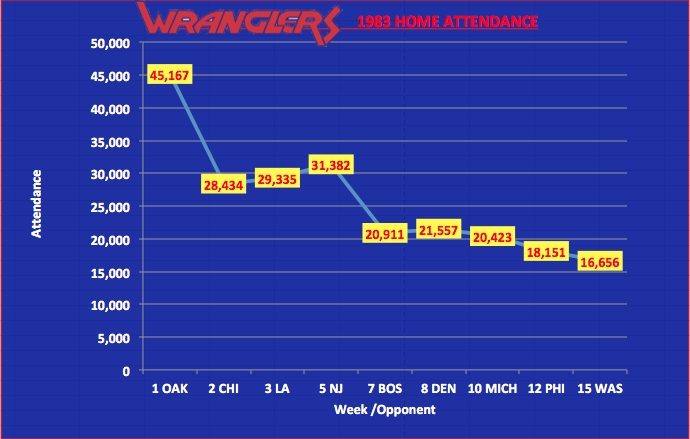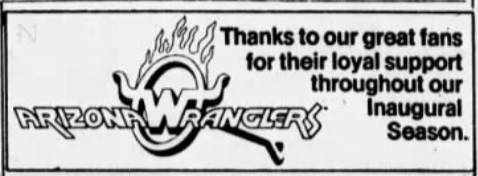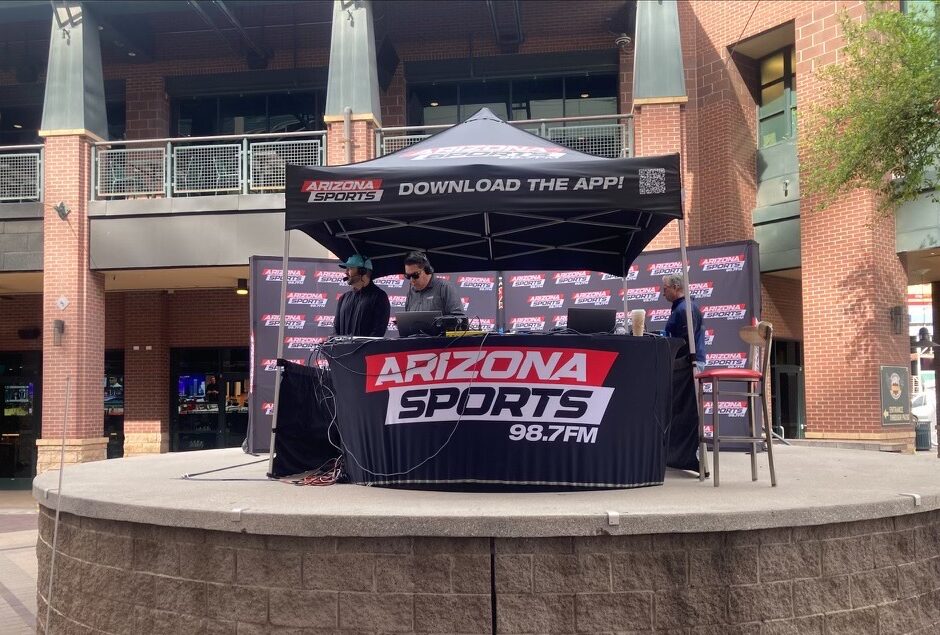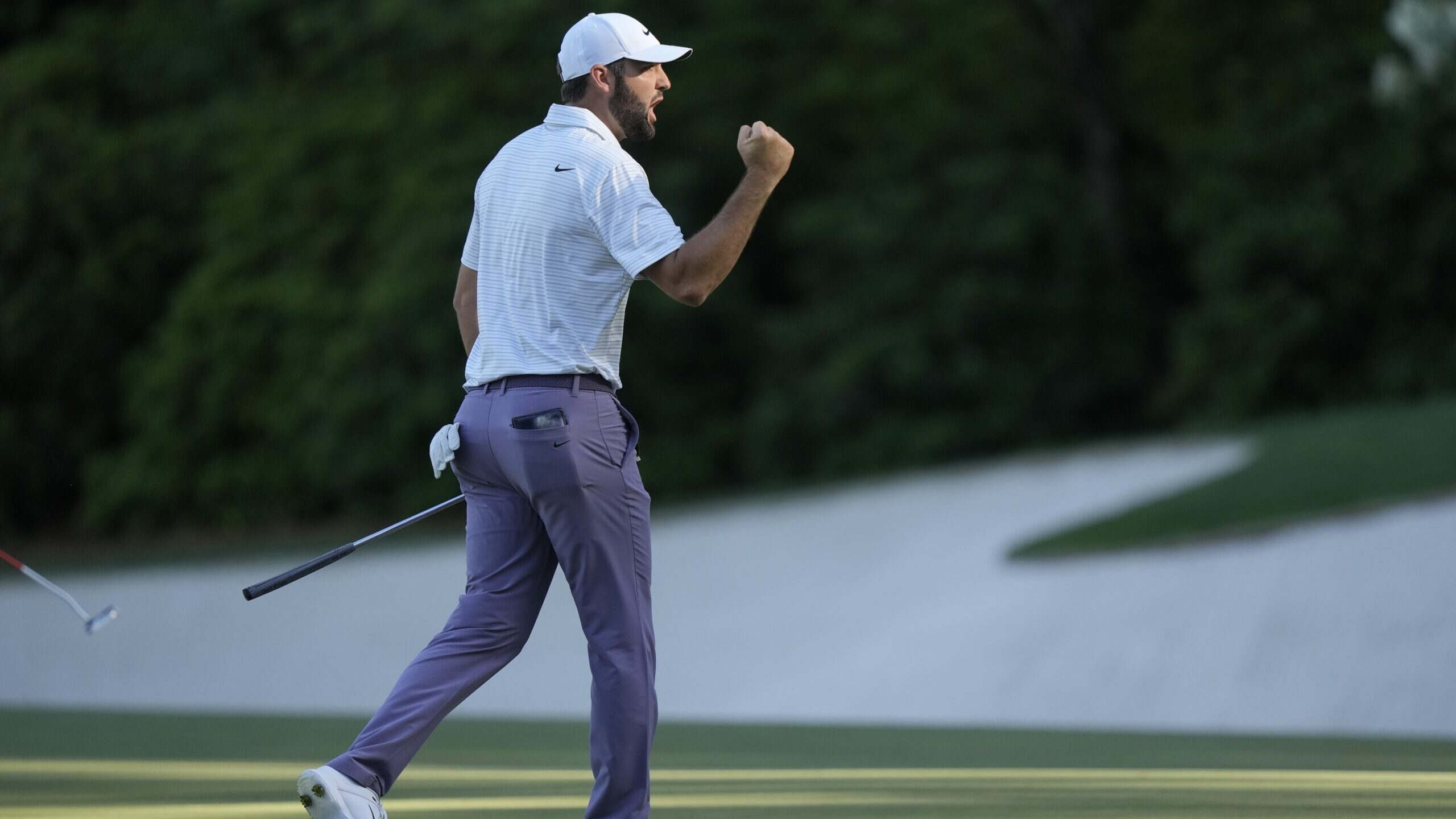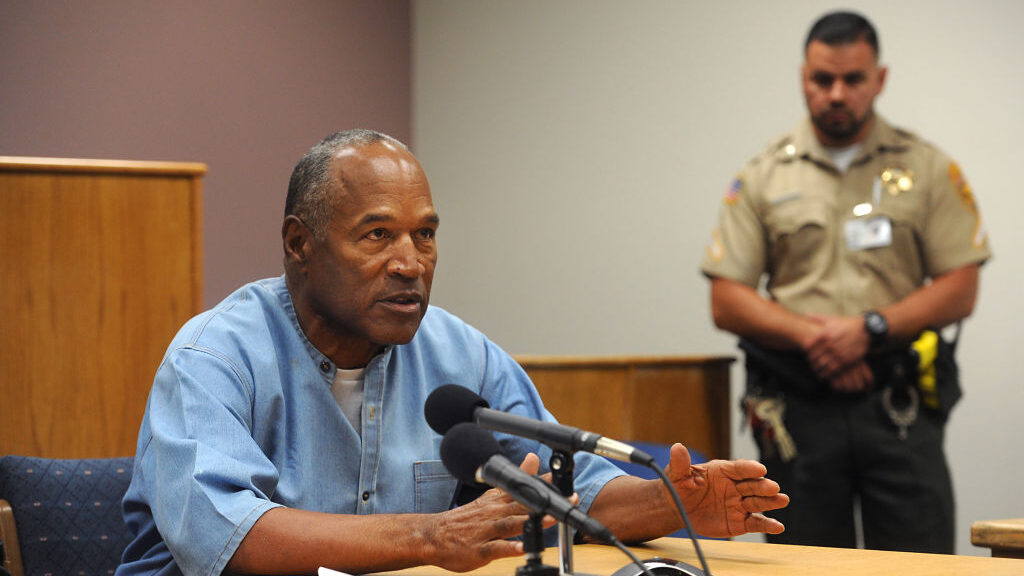Branded: The story of Arizona’s original football team, the 1983 Wranglers
Mar 6, 2018, 11:17 AM | Updated: 12:03 pm
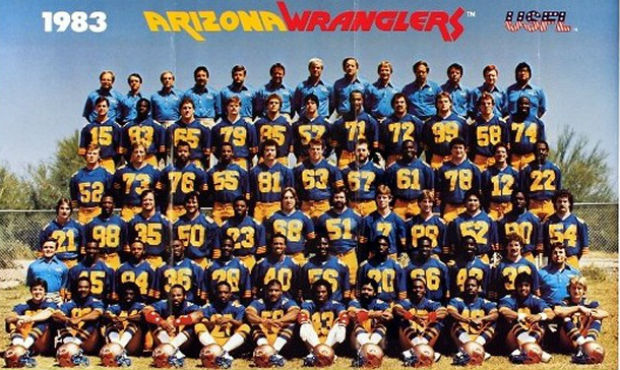
For almost two decades, the fledgling desert city of Phoenix boasted one major league sports franchise. To the surprise of many, the National Basketball Association granted a 1968-69 expansion franchise to Phoenix, a city whose population hovered around 500,000.
The Suns were born. The St. Louis Cardinals of the NFL moved west in 1988.
You may not know this, but the Cardinals weren’t Arizona’s first pro football franchise. Neither were the Arizona Rattlers of the Arena Football League.
That distinction belongs to the Arizona Wranglers of the United States Football League, who were born under uncertain conditions in the summer of 1982.
On the 35th anniversary of the first pro football game played by an Arizona franchise, here’s a look back at that tumultuous inaugural 1983 season for the Wranglers told by some of the men who participated in it.
Origins
Owner Jim Joseph and partner Tad Taube had planned to field a franchise in the Bay Area. Taube became more active in the process while Joseph took a back seat. The pairing split, with each owner ending up getting a USFL franchise, and it was Taube who won the rights to the Bay Area franchise in the most democratic way possible — a dice game.
How did our founder, Tad Taube, become the owner of the USFL Oakland Invaders? By winning the rights to the Bay Area’s USFL franchise in a dice game with USFL co-founder Jim Joseph. Yes, a game of dice.https://t.co/49GOl48v3o #football #Oakland #USFL #OaklandInvaders
— Taube Philanthropies (@TaubePhilanthro) December 22, 2017
As the loser of the game, Joseph chose the Los Angeles market, but that wasn’t to be either, thanks to San Diego-based franchise owners Bill Daniels and Alan Harmon.
Jeff Munn, Sports Reporter for KNIX radio: “The owners of the San Diego franchise were big into cable TV, so the league decided let’s give them the L.A. franchise because it’ll be better for them to be in L.A. Jim Joseph, who owned the L.A. franchise, decided to come here instead of going to San Diego — where the operators of Jack Murphy Stadium were difficult to negotiate with about facility usage.”
The league approved the move of the franchise to Phoenix in August of 1982.
So Phoenix finally landed a team. Sure, it wasn’t part of the original plan — or the backup plan, for that matter — but it was part of the 12-team league, nonetheless.
Munn: “This market was so desperate for pro football, when it was announced they were coming, mostly everybody was doing back flips over it. There were those of us who realized this is not the NFL. They had staged preseason games at Sun Devil Stadium and you realized this is not the top level of pro football, but it was a national league with national TV contracts. Everything about the Wranglers was behind schedule.”
The Arizona franchise finally got a name a month later. In September of 1982, the Wranglers were officially born when 30-year-old Adrienne Hogate’s entry was chosen by Mayor Margaret Hance from over 20,000 entrants in the contest. In a poll conducted by the Arizona Republic, the name “Rattlers” actually received the most votes from readers, edging out “Scorpions.”
Hogate (to the Republic in 1982): “I tried to think of something connected with Arizona. I thought of cowboys, but Dallas already had the Cowboys.”
So they had a name. In late October, Joseph picked a flaming branding iron with a bold ‘W’ as the team’s logo.
Now there was just that little matter of building the roster.
Player Acquisition
The inaugural USFL Draft was held January 4-5, 1983.
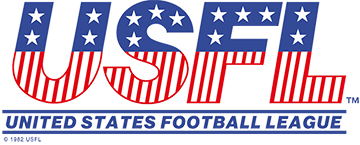 Not deterred by the stronger, more established NFL, general managers around the league began selecting big-name players. With the first overall selection, the Los Angeles Express took Pittsburgh quarterback Dan Marino.
Not deterred by the stronger, more established NFL, general managers around the league began selecting big-name players. With the first overall selection, the Los Angeles Express took Pittsburgh quarterback Dan Marino.
The Wranglers, following a trade with the Chicago Blitz, owned the sixth overall selection and took SMU running back Eric Dickerson, who had run for 3,045 yards and 36 touchdowns over his last two college seasons. Dickerson had teamed with Craig James (picked fourth overall by the Washington Federals) to form the record-setting “Pony Express” backfield for the Mustangs.
Now, the only question was whether or not the thrifty Wranglers would be able to lure Dickerson to the desert before the NFL Draft was to take place four months later.
Eric Dickerson, Wranglers draft selection: “I was disappointed that I was the sixth overall pick. I remember thinking ‘I’m better than that.’ I didn’t know anything about Arizona at all. I’d never been to Arizona ever.”
That would change.
Dickerson: “I came there for a press conference after draft day.”
Munn: “They brought him to town for a press conference and we were all standing in the room going ‘this guy is not signing here.’ We didn’t know where he would go but we knew he’d be a top three-or-four pick in the NFL. You just thought, there’s no way. The press conference, for those in the media, in the back of our minds, was kind of a farce. Yeah, it’s great that you brought him here, but he’s gonna sign with the NFL.”
That prevailing thought didn’t stop Joseph from trying to land the big fish. According to reports, the Wranglers offered Dickerson a five-year, $5 million contract with base salaries of $200,000 per year and the other $4 million deferred over the next 27 years.
Not surprisingly, Dickerson’s agent, Jack Mills scoffed. “It’s not like Eric doesn’t have someplace else to go,” he said, referring to the NFL Draft in April.
Dickerson says his mind wasn’t made up by the money — or lack thereof — offered by Joseph and the Wranglers.
Dickerson: “It was all new to me. The only thing that I recall was that my great Aunt that raised me, I told her that Arizona had drafted me. She didn’t like football. She said, ‘I don’t like that sport, Eric.’ I asked her which one should I go to. Should I go to the USFL or the NFL? I will never forget her answer. She said ‘let me ask you a question — which one has been around longer?’ I said ‘the NFL.’ She said ‘go to that one. That other one ain’t gonna be around.’ That made my decision for me right there. Honestly, I never gave it another thought.”
Dickerson was selected by the Los Angeles Rams with the second overall pick of the NFL Draft. He went on to a Hall-of-Fame career that spanned 12 years with four teams and still holds the single-season league record with 2,105 rushing yards.
If Dickerson had given another thought, that would have been squelched by the record-setting contract the New Jersey Generals gave Georgia’s Heisman Trophy winner Herschel Walker — a $5 million pact that ran for three years — a deal that dwarfed the contract of the NFL’s highest-paid running back, Walter Payton of the Chicago Bears.
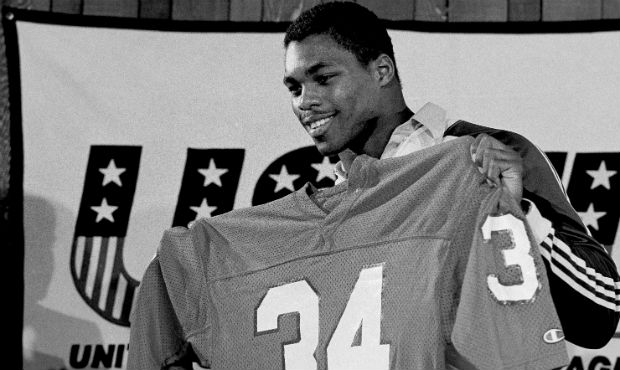
Former Georgia football player Herschel Walker holds up his new jersey at a press conference in Orlando, Fla., Feb. 26, 1983. Walker joined the New Jersey Generals of the USFL and worked out for the first time at their spring camp at the University of Central Florida. (AP Photo/Ron Lindsey)
Even though Dickerson never wore the colors of the Wranglers, there may have been reports of him being sighted at training camp in February of 1983.
Tony Neely, Defensive Back: “It’s funny, because when I signed and I came into training camp, a lot of people thought I was Dickerson. I had the glasses back then and I had a lot more hair then. I was like, ‘no, I’m not Eric.'”
Neil Balholm, Wide Receiver: “I remember thinking ‘wow, that would be awesome if he came here.’ But around the team, it never really got that deep into what was happening.”
In total, the Wranglers chose 23 players in the regular portion of the draft, including a player who had made a bit of a name for himself by leading LSU to the Orange Bowl following the 1982 season.
Alan Risher, Quarterback: “I started in the Senior Bowl. I had some credentials, but from what I was hearing, the underlying scenario was that if I was drafted (by the NFL) — and back then, they still had 12 or 13 rounds — I was going to be a late-round pick and somebody might take a shot on me. It wasn’t anything that I was hanging my hat on.”
The Wranglers nabbed Risher in the 15th round.
Risher: “I’ll be honest — I didn’t even know I got drafted by the Wranglers until I picked up the paper and said ‘huh, I got drafted by the Wranglers.'”
Risher was a familiar name and face to Wranglers COO Harry Hulmes, who had spent 13 seasons in the front office of the New Orleans Saints.
Risher: “Harry obviously had seen me play a lot of football at LSU. He had a lot of good things said to him about me, and that’s kind of why he insisted that they were going to draft me as a quarterback.”
Since 12 teams had to stock rosters from the ground up, the league instituted a Territorial Draft as well. The Wranglers chose a total of 26 players from Arizona State, Arizona, Northern Arizona, New Mexico and New Mexico State.
Eight former Arizona Wildcats were taken in that portion of the draft, including defensive back Neely.
Neely: “I really didn’t know how it was going to work, because it being my senior year, I was really looking toward the NFL Draft. I was married while I was in college and I had a son, so my agent told me ‘hey, we can get you third-round money.’ But actually my contract was guaranteed (by the Wranglers). That’s pretty much the main reason I signed.”
Five former U of A players including linebacker Glenn Perkins, offensive lineman Jeff Kiewel, center Glenn McCormick and tight end Mark Keel made the squad alongside Neely.
Neely: “That did help the transition.”
Keel, who was coming off a solid senior season in Tucson, during which he caught 32 passes for 513 yards and two touchdowns, was excited to play in the state he called home for four years.
Keel (to the Arizona Republic in 1983): “I talked to some people on the team and they pretty much explained the offense to me, and I liked what I heard. Plus, I can come in and play.”
Yet, there was still a great deal of unknown to the players. A new league in a new pro football market? Players who latched on to the fledgling league were, in a way, taking a leap of faith.
Neely: “There was really no fear or concern going into a new league. I knew the competition would be good. With the ability that I had, I knew I would do alright. So I had no trepidation for it being a new league. When I saw some of the ownership that was coming into the new league, I thought it would be pretty solid.”
The Wranglers also scoured free agent lists to fill gaps on their roster.
Dan Manucci, Quarterback: “I was cut (by Green Bay in training camp in 1982), so what I did was have my dad, who acted as my agent, he made some inquiries for me about this Arizona Wranglers team. And they said ‘we can’t talk to your son, because Dan’s property of the Chicago Blitz’, because I played at Kansas State. The Packers cut me and since I had to file a grievance (to collect on money owed on a guaranteed contract), I’m probably not going back to the NFL soon. Here’s an opportunity to go play in the USFL, to play in the spring and then, maybe someday, get a chance to go back to the National Football League. George and Bruce Allen were handling everything with the Blitz. So my dad calls and says ‘if Dan’s gonna play in the USFL, it’s going to be in Arizona. He’s from here.’ So I get a phone call from George Allen about a week later out of the blue and he says ‘Dan, it’s George Allen and your dad talked to me about going to Arizona, but we really need you. We’ve got Greg Landry at quarterback and we’d like you to come in and compete.’ I said ‘you know what, Coach, if I’m going to play in the USFL, I’d really, really like to stay home.'”
And home it was for Manucci, who had spent a few seasons with the Buffalo Bills and one in the Canadian Football League with the Toronto Argonauts.
The Wranglers also swung a trade with the Michigan Panthers for lefty quarterback Todd Krueger, who like Manucci, had spent time in the NFL with the Bills.
But who would be on the other end of this trio’s passes? One free agent option was Balholm, who was on the receiving end of a lot of passes from Jim McMahon and Steve Young at BYU.
Balholm: “My thought was to see what the NFL would provide to me, but even at the end of the 1982 season, we had heard about this new league that was starting up, the USFL. At our bowl practices, there were some representatives from the league that came around and said ‘hey, this is what we’re planning on doing. Keep an open mind when you consider your options.’ I didn’t think about it that much, but I did think it sounded pretty cool.”
As cool as it sounded, Balholm’s phone didn’t ring during the two-day draft.
Balholm: “I didn’t get drafted by anybody, so I waited it out and finished my Master’s Degree at BYU. About three weeks into training camp, I got a phone call from the player personnel man, Bill Baker. He said ‘hey Neil, I was scouting Jim McMahon. I came to one of your games and I just happened to see you and I really like the way you ran your routes and how you caught the ball and I’d like you to come play for us.’ We quickly worked out a deal and in probably 24 hours or so, I was on a plane from Provo to Phoenix.”
Another receiver, Jackie Flowers, a former Florida State Seminole who got a cup of coffee in the NFL with the Buccaneers, was brought in with little fanfare. There was a reason there was such little attention paid to Flowers’ tryout.
Balholm: “He told me he was driving a truck before he got the call from the Wranglers.”
With the roster stocked, at least in terms of names, the team still needed a coach.
A week after the draft, Arizona became the 11th USFL team to find its man. They tabbed Doug Shively, who had spent the last six seasons as the linebackers coach for the Atlanta Falcons under coordinator Jerry Glanville.
It was the first head coaching opportunity for Shively, who also had defensive assistant experience with Virginia Tech, Kentucky, Clemson and North Carolina.
Hulmes conducted the search, which was linked to some big names, like former ASU and Notre Dame head coach Dan Devine. The search lasted some six weeks and saw Hulmes pivot to interviewing NFL assistants after a string of rejections from prominent college coaches.
Munn: “Because they were so behind schedule, everyone else had their coaches. The Wranglers had to just grab who was available, and that’s how they ended up with Doug Shively, who was a really nice man, but it was his first head coaching job. He’d been an assistant his whole career.”
Training Camp
A quarter of the league’s teams came to the Valley to hold their inaugural training camps. The Wranglers weren’t one of them.
The Chicago Blitz worked out at Glendale Community College. The Denver Gold took over North High School while the Oakland Invaders set up shop at the defunct East High School — on North 48th Street just north of Van Buren and became the in-season practice facility of the Wranglers.
So, Arizona traveled about an hour south, to the Francisco Grande Resort in Casa Grande, Ariz.
Balholm: “Franny Granny is what we called it.”
A 35-day stay awaited the team, and they weren’t the only pro athletes there. The California Angels were holding their spring training workouts at the same facility.
Risher: “I remember getting on an elevator with Reggie Jackson — I thought that was pretty cool.”
Manucci: “The California Angels had spring training at Francisco Grande, too. So we had a couple of fields next to them and the Angels would be over there — off to the side there.”
That might have been the only good memory about the camp.
Neely: “When I think about football, that experience actually was one of the worst football experiences I ever had in my life.”
Manucci: “We were down at Francisco Grande, and I tell you what, it was like Camp Kush. It was running and hitting and scrimmaging. By the time four-and-a-half weeks were over, we were spent. We were just toast. The ASU guys we had on our team — Ben Apuna, Jeff McIntyre and Ron Sowers — they were like ‘this is just like Frank’s camp all over again.’ Quite frankly, it was probably more running than Frank ever did at ASU.”
Balholm: “We were there for a long time doing our thing and the fields were really crappy. It was kind of like a boot camp.”
Neely: “You were hitting constantly. As far as the defense, it wasn’t something that I was used to. We hit a lot in college at Arizona, but that training camp was going to the next level. I had never experienced anything like that in my life. I actually got hurt in training camp — probably in the second week — and it caused me to miss the first three weeks of the season. I separated three ribs from my sternum. To this day, when it gets cold, it still bothers me.”
Then there was the matter of camp finances for the players. An anonymous player told Republic beat writer Walt Jayroe that the players were paid $5 per day in per diem. “Somebody figured it out that we’re making 7 cents an hour from the time we get up until the time we go to bed. You’ve got to love the game,” the player said.
Neely: “Five dollars a day per diem. I think it might have been 25 dollars during the season. I know it wasn’t much, though.”
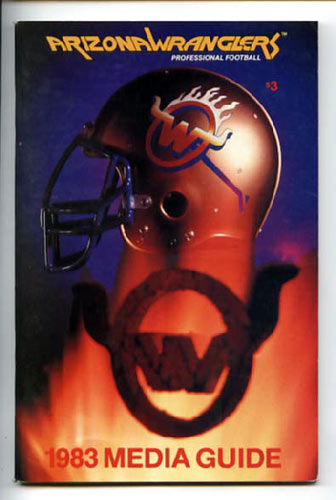 Balholm: I think (Joseph) was a pretty cheap guy. The salaries weren’t generous. The bonuses were OK. We were kind of on a shoestring budget, I think.
Balholm: I think (Joseph) was a pretty cheap guy. The salaries weren’t generous. The bonuses were OK. We were kind of on a shoestring budget, I think.
The camp had many purposes, including finding a starting quarterback. There was no shortage of passers in Casa Grande. Risher, Krueger and Manucci were joined by Craig Penrose, former ASU signal caller Dennis Sproul and Leamon Hall, Army’s all-time leading passer, who hadn’t played organized ball since 1977, because of military commitments.
Manucci: “At that time, I was really the only quarterback with pro experience before training camp started. But they signed me, they signed Craig Penrose, and they signed Dennis Sproul and then they got Todd Krueger. Todd was with me in my second year in Buffalo, but they put him on injured reserve.”
Risher: “It was an old school training camp because they were trying to weed out a lot of people. I don’t think there was a limit on the number of people you could have in training camp and when I got there, we had seven quarterbacks. I was like ‘damn, how am I gonna get a rep?'”
Manucci: “Sproul didn’t come until about two weeks into training camp and he lasted about a week, because I think at that time, he’s knees were shot. I think he had played a year in Green Bay, but he couldn’t take all the running, because his knees were shot. I think Craig Penrose lasted like three days. I saw him one night and he said “I’m out of here — this is crazy. This is nuts.” So he left and the Gold signed him.”
Risher: “Dennis Sproul from Arizona State was there and then you had Krueger and Manucci and me and three other guys — I can’t even remember their names. You had a lot of guys trying to play quarterback, so it was an interesting deal the first week or two until they weeded out everybody.”
Curt Feldtkeller, Marketing Representative: “In year one, we had Harry Hulmes, who was the former assistant GM of the Saints and he was amazing. Very cool guy. We were down in Casa Grande and me and Harry were talking. And Todd Krueger was the starting quarterback, Manucci was number-two and they had just brought in Alan. And Harry, I remember the very first practice that Alan was at, points to Alan and says ‘there’s your quarterback right there.’ I said ‘isn’t he number-two on the depth chart?’ He said ‘oh, he’ll be starting.'”
The field was whittled to four, and then three when Hall was let go prior to the season opener. Krueger was chosen to start at quarterback in the season opener.
Risher: “I didn’t have the greatest training camp, if I remember correctly. I just got finished playing a full fall season at LSU and I played in the Orange Bowl and the Senior Bowl — I was kind of burned out after training camp in February. People didn’t realize I was coming out of five or six months of getting beat up myself, so when I got to training camp, I was already kind of beat up.”
Manucci: “I was bummed because Todd was starting. Oakland had a veteran team and I had some success against them in the scrimmages.”
Ready or not, it was just about time to play.
Marketing the New Team
Leading up to the season, the Wranglers put on an all-out media blitz promoting “pro football’s hot new team” as a catchy television jingle called them.
The team was selling, and many fans were buying.
Manucci: “We had billboards and me and some of the other guys were doing commercials. It was fun. I really liked it — I loved it.”
Balholm: “The fans were hungry for football. I knew that. We kind of put them on the map for professional sports, after the Suns. There was so much excitement for the team.”
Feldtkeller: “The Valley was so thirsty for football, so that created so much opportunity. We had this thing called the Corral Club, which were places that would run buses of people to the games. They’d buy a block of 150 or 200 tickets and then they would put those in a package and run the people to the stadium. That became extremely successful as well.”
Feldtkeller and the marketing department faced some challenges not normally associated with pro football. Since the Wranglers were playing on a college campus, beer sales were forbidden at the time.
Feldtkeller: “You couldn’t do liquor sales at ASU. We could give liquor away all we wanted on the stadium grounds, but we couldn’t sell it. So we developed a couple different membership areas in the stadium where we would do a pregame tailgate party, and we gave away food and liquor and all kinds of stuff there.”
They got pretty aggressive with giveaways, too.
Munn: “I remember in ’83, and I don’t know how they paid for this, they gave away a car every game. Dodge would randomly pick a fan and boom, they’d win a car. I think Dodge, at that time, was still just coming out of bankruptcy, and they’re just giving cars away?”
Feldtkeller: “All of our promotions were really awesome. I remember we got Checker Auto to do safari hats and pretty much everything we did was related to the heat. We were very successful to get companies to pay for that stuff. We didn’t fall off the map with attendance, but it got pretty damn hot.”
Fashion-wise, the Wranglers celebrated their status as Arizona’s team by basically wearing the state flag on game days. Copper helmets with the distinctive branding iron logo were coupled with blue, gold and red uniforms.
Munn: “The uniforms — I loved the uniforms.”
The radio rights were also coveted. In 1983, not every Wranglers game was scheduled for television broadcast, despite the contracts in place with ESPN and ABC.
Munn: “KTAR had just acquired the ASU rights and it propelled them to the top of the ratings. So KOY was the other dominant AM station and they’re in a panic. So here come the Wranglers. KTAR was invested in the Suns and ASU, so they weren’t that interested. KOY jumped on it, got the rights, and hired Ray Scott to be the play-by-play guy. ”
Scott was teamed with KOY sports talk host/color commentator John Moynihan, was the longtime voice of the Green Bay Packers during their glory days under legendary head coach Vince Lombardi. He was inducted into the Pro Football Hall of Fame in 2000.
 Munn: It was really a shot of credibility to have Ray Scott as your radio play-by-play guy.
Munn: It was really a shot of credibility to have Ray Scott as your radio play-by-play guy.
The games not televised live by one of the national networks were broadcast on a tape delay basis by KPNX Channel 12 with sportscasters Bill Denney and Steve Pascente on the call.
The Opener
After that grueling training camp, the Wranglers kicked off their inaugural season March 6, 1983, but there was more on the agenda than just football. The Wranglers booked a pregame concert by the legendary Beach Boys, which proved to be quite an extravagant expense.
Newspaper reports at the time estimated the total bill to be in the neighborhood of $65,000.
Feldtkeller: “That might be embellished a little bit, but it had to be all of 50-grand. We put The Beach Boys up at the Pointe Tapatio. We put them up there in these massive casitas. It was non-stop for three days for them of drinking and eating and everything was on us. It was pretty crazy.”
A crowd of 45,167 — the biggest in the USFL’s opening week of games (besting the total at Mile High Stadium for the Denver Gold vs. the Philadelphia Stars by 65 fans) settled in for some football against the Oakland Invaders, a Pacific Division rival.
Their new team didn’t give them much to cheer about.
Oakland, led by former Denver Broncos head coach John Ralston, jumped out to a 7-0 lead when quarterback Fred Besana connected with Wyatt Henderson on a 53-yard touchdown pass in the first quarter.
Turns out, that’s all Oakland would need.
Arizona’s offense, led by Krueger, couldn’t do anything. He completed 10-of-19 throws for 96 yards before being replaced by Risher. The results weren’t any better.
Fans would go home without seeing the Wranglers score a point in a 24-0 loss.
Owner Jim Joseph (to the Arizona Republic): “The enthusiasm was excellent. Obviously, the enthusiasm would have been greater had the score been different. I think for the Chicago game (next Saturday), we would have had 60,000 people. Now you won’t have that. Arizona fans expect a winner and they should have a winner. I don’t like being a loser. I feel worse about it than the 45,000.”
Balholm: “The first game was disappointing. We could have done better. I don’t know if we had all the right guys in the right positions yet.”
Manucci: “What I remember most was the excitement, the energy from the fans. It was like ‘wow, we’ve got pro football here in the Valley.’ I bet we might have had 40 or 45-thousand people and we just laid an egg. But you’ve got to understand, they had a lot of veterans. We had a lot of rookies and maybe a handful of veterans. You know, Aaron Mitchell, myself, Ben Apuna and some others. They were a veteran, established team and they basically kicked our butt.”
Munn: “To me, it was like bizarro world — we were playing a football game in March. At that time it seemed like we were in the Twilight Zone. It’s March and we’re playing a pro football game. But it came off really well. They lost, but the show was pretty good.”
If there was a bright spot on a dark opening day, it was the play of Balholm. The rookie caught four passes for 57 yards, which was almost a quarter of Arizona’s offensive output.
Balholm: “It was a really good game for me — I got player of the game. So I remember that as a pretty good game.”
It’s funny, Balholm almost didn’t get there.
Balholm: “I almost missed that game. Our coaches used that rule of even though we live in town, we couldn’t stay in our own place, because they didn’t trust us. So we were staying at the downtown Hyatt, they put us up the night before the game. Everyone is leaving for the stadium, and my roommate at the time was offensive lineman Vince Stroth. He overslept or something and I’m calling him and he’s not answering. It’s an hour before game time and I’m not there. I’m too stupid and cheap to take a cab, so I’m sitting there going ‘man, I’m not going to be there. What am I gonna do?’ Luckily, he comes out of nowhere and I said ‘you’ve gotta get me there.’ I get into the locker room and the guys are already on the field and I’m stressed to the max.”
Speaking of stress, the Wranglers’ second game of the season was a home tilt six days later against the Blitz — a team picked by most league pundits to win the first championship.
The Upset of Upsets
Not only did Chicago hold training camp in the Valley, their owner was a prominent Phoenician. Dr. Ted Dietrich, founder of the Arizona Heart Institute, owned the Blitz, and made himself feel right at home in Week 2.
Munn: “Dr. Ted Dietrich, he had a bunch of his friends come out in a party bus. They didn’t have suites at the time at Sun Devil Stadium, so they might have been in the loge. So he’s got all his friends there and George Allen is his coach — everything points to the Blitz are going to steamroll this rag-tag bunch of football players into the ground.”
Manucci: “We were a little fired up because we got blown out the first week and here they come, an experienced team with Greg Landry and other veterans.”
Due to the failings of the offense, Shively made a switch at QB, inserting the rookie Risher into the starting lineup.
Risher: “It was in the week leading up. Shively told me on Tuesday after we had our day off, that they were going to throw me in there and see what happened. I was preparing to start — I felt comfortable. I had started my whole life from the time I was seven years old, so I shouldn’t have had a problem with the reputation of the Blitz — George Allen and all their veterans and stuff. Honestly, I was a little bit apprehensive to get my first start against the favorite to win the USFL championship, but it all worked out.”
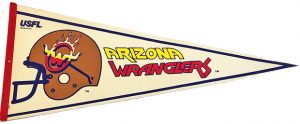 Risher had been called “lame-armed” by Arizona Republic columnist Bob Hurt after the opening week shutout against Oakland. Hurt wasn’t the only one who shared that view.
Risher had been called “lame-armed” by Arizona Republic columnist Bob Hurt after the opening week shutout against Oakland. Hurt wasn’t the only one who shared that view.
Munn: “Alan Risher — the only way that guy could throw a ball 60 yards in the air is if he threw it five times and picked it up every time and added it up. He just didn’t have a great arm. It was literally like they were drawing up plays in the huddle, like ‘you go this way, you go this way’ — like street football. He’s just running around, looking for guys.”
That style, eventually, would work.
Chicago, a 13-point favorite, jumped out to a big lead. When Greg Landry hit tight end Paul Ricker with a 15-yard touchdown pass in the fourth quarter, the Blitz led 29-12.
Manucci: “We get down early and all of a sudden, Risher completes a pass to Flowers and Mark Keel — he had a big game. Our running game got going and we had some blitzes and got to Landry. Suddenly, we’re back in the game.”
That’s when the fun started.
Risher led a furious comeback, first hitting Flowers on a 10-yard touchdown pass. Needing a two-point conversion at some point, Shively called for it.
The Wranglers snapped the ball from the Chicago 3-yard line, and Risher immediately started scrambling. He retreated all the way back to the 30-yard line before uncorking an awkward, lunging throw toward the end zone, which Keel caught for the two-point conversion.
Risher: “You’re not going to believe this, but I’m going to tell you the God’s honest truth. We had worked on this play that week for a two-point possibility, and I lined us up in the wrong formation for the play I’d called. I choked and lined us up in a right formation instead of left. When I got to the line of scrimmage, I realized that Mark Keel — the guy I was supposed to throw the ball to — was lined up on the wrong side of the ball. So I started to zig-zag things pretty quickly because I knew I’d screwed up the play up and I was trying to buy time. The scramble wasn’t all that spontaneous. I knew what I was getting into because I already screwed the call up. It worked out. But that’s the reason why it was kind of a wacky-looking deal, because I screwed it up.”
Great play, yes, but Arizona still trailed 29-20 with under seven minutes to play.
The Wranglers got the ball back and faced a fourth down from the Chicago 16-yard line. Risher pitched to tailback Harold Blue, who got the first down, but fumbled forward. Blue, the only player who could have legally recovered it, did. It was Blue’s only carry of the game.
Risher then hit Balholm on a 9-yard touchdown pass two plays later, and things were getting very interesting. The Wranglers then forced a Blitz punt. Trailing 29-27, they took over at their own 43-yard line with a little over a minute to play.
A completed pass to Balholm for nine yards got Arizona into Chicago territory. On 2nd-and-1, Risher rolled right, looking for Keel, and pushed a pass forward — right into the hands of safety Luther Bradley, who had nothing but green grass and a victory in front of him. Bradley, who had spent four years with the Detroit Lions, flat-out dropped the ball.
Balholm: “Risher should have thrown a pick-six to Luther Bradley and it hit him right in the hands. He had nobody in front of him.”
Three weeks later, Bradley would set a professional football record by intercepting six passes in one game — a 42-3 shellacking of the Tampa Bay Bandits — but he couldn’t ice this game in Arizona.
Risher drove the Wranglers to the Blitz 17-yard line with just four seconds left, setting the stage for a last second game-winning field goal attempt by rookie Jim Asmus, who would spend most of his time in Arizona (he didn’t last the whole season) in Shively’s doghouse.
But Asmus connected, giving the Wranglers an impossible, 30-29 win over a team some thought could compete in the NFL.
Manucci: “The place went nuts.”
Munn: “There’s utterly no explanation for how that happened.”
Balholm: “It meant everything to the players, the coaches and the town. George Allen and his team coming in there. They had a pretty healthy payroll and a lot of stars.”
Risher: “It was all kinds of crazy stuff that happened. I still watch the replay every once in a while on YouTube just from a memory standpoint, because it was such a great called game. Tom Kelly, the great voice of USC football was on ESPN’s coverage of the USFL at the time. Tom Kelly was one of the great broadcasters of all-time and he had Don Heinrich doing the color. They did a fabulous job.”
If the broadcast booth did a fabulous job, it didn’t rub off on the graphics guy in the truck. For most of the game, Risher’s name was misspelled on-screen.
Munn: “How did they not know this? They’re taking tight shots of the back of his jersey.”
Hey, you engineer a comeback like that, they’ll figure it out. Risher got his just due after the game.
Shively (to ESPN crew): “I’m just so proud of them, I can’t hardly stand it. It was a great effort, they fought right down to the end and I think we defeated a great football team also. I know this, I’m the proudest man in the world tonight for my football team. I’m just glad to be a part of it.”
Risher: “We scored 18 points in the last eight minutes to beat them. One of the things that happened that was divine intervention, if you want to call it that, we had some crazy stuff in that last five or six minutes — we recovered a fumble, and the only guy that could have recovered the fumble was the guy that fumbled because it was fourth down.”
Shively (to ESPN crew): “I thought he played an excellent game tonight. We knew Alan was a good one as far as confidence and letting him getting in there and letting him play. He did just that tonight.”
Risher: “After the Blitz game, Jim Joseph came up to me after the game in the locker room and obviously he was beaming because we won. He said ‘man, I ain’t never seen nothing like that — you running around back there — you were Fran Tarkenton!'”
For Valley sports fans, Risher’s performance was a kind of precursor to another QB who would play with that reckless abandon on the same field in Tempe a decade later — Arizona State’s Jake Plummer.
Risher: “Plummer’s build was kind of like mine. I was skinny as a rail, I didn’t have much meat on me, and Plummer didn’t have a whole lot on him either.”
Feldtkeller: “Risher was the reincarnation of Fran Tarkenton or Roger Staubach, because he had to run like hell. We had a terrible offensive line.”
Balholm: “We made it work, especially after Risher came in. He was such a good scrambler and able to keep a play alive. I can’t tell you how many plays I made on broken plays when he was just scrambling around.”
The Wranglers followed their epic upset by taking down the L.A. Express the next week, 21-14. Risher threw a 45-yard touchdown pass to Flowers while fullback Steve Howell, who was Larry Csonka’s backup with the Miami Dolphins in 1979, ran for 98 yards and a touchdown in the win.
The no-name Wranglers were suddenly 2-1.
Risher: “We ended up beating L.A. So we’re 2-1 and we’ve got a rookie quarterback playing well and throwing touchdowns, so yeah, it kinda got going there.”
Manucci: “We were the talk of the USFL for a couple weeks.”
Arizona’s next game would be there first on the road — against the Birmingham Stallions, a team that had started 1-2 and was having trouble scoring points.
The game was a nationally-televised affair on ESPN and was marred by horrific weather conditions in the area. Team officials estimated the attendance to be around 5,000.
The Stallions still struggled to score, but did so more than the Wranglers in an ugly 16-7 win.
Manucci: “It was raining and raining, there were 45-to-50 mile-per-hour winds. We still played the game with hardly anybody in the stands.”
Risher: “The weather was the worst I have ever seen in the history of me playing football. We were in the old Legion Field, and they had a cover on one side of the field for fans and everybody huddled up underneath the overhang of the stadium. It was awful — you couldn’t throw the ball in one direction. I was terrible. There was 35-to-40 mile-per-hour winds and you couldn’t throw the ball. You could only try to move it when you had the wind.”
Balholm: “Legion Field had one of the worst fields in the world. It was hard and it was really a tough place. I can’t explain how bad the wind was. When you throw a ball, and it’s moving like a Kershaw curveball, it was like all over the place. And you’re trying to watch it into your hands and it’s raining and it’s cold. I think there was just a few people in the stands, it was so bad. They probably should have canceled it or postponed it or something. It was miserable. It was just a miserable time.”
Week 5 brought Herschel Walker and the Generals to the desert. Walker hadn’t lived up to his massive contract in the first four games of the season, and New Jersey was off to an 0-4 start, giving the league it’s first big disappointment.
That didn’t last. Walker rumbled for 177 yards and three touchdowns on Easter Sunday, and the Generals knocked off the Wranglers, 35-21.
Neely: “Walker had just got married and in the first part of the season, he didn’t really do anything. He came out and they played us out here and I think he rushed for, it seemed like, over 200 yards, I can remember that. He just went crazy. The guy was so big and so fast and quick as a cat.”
Walker’s arrival also meant a bit of a spike in the Wranglers’ attendance, which had dipped since drawing over 45,000 in the opener. A crowd of 31,382 flooded through the Tempe turnstiles to watch the most-talked about running back in football.
Munn: “The crowds went down in a real hurry after those first few games. I mean, they had a good crowd for the New Jersey game, because of Herschel Walker. After that, it was pretty common to have 16-to-20 thousand.”
The Wranglers traveled to the nation’s capital to face the Washington Federals in Week 6 — a Monday night game on ESPN. Arizona trailed 21-13 at halftime, but got an Asmus field goal and a 98-yard touchdown pass from Risher to Flowers early in the fourth quarter to win 22-21 and even their record at 3-3.
Another loss awaited at home, as the Boston Breakers broke the Wranglers, 44-23 at Sun Devil Stadium in what was the sloppiest performance to date.
Frank Kalil, offensive guard (to the Arizona Republic): “I’m just embarrassed. I’ve never been beaten that bad in my life. You can’t get yourself in a hole the way we’ve been playing. We don’t exactly blow anybody out.”
Shively (to the Casa Grande Dispatch): “I wasn’t pleased with anybody. There’s not a whole lot that can be said when you get your fanny kicked. When you spot people 10 points by blatant errors then everything else is uphill. I’m embarrassed by the way we played. There is no excuse for the mistakes we made. I thought our defense followed pretty good in the first half, they just lost their heart. I have to take some of the blame too. My job is to have them ready to play and obviously, they weren’t. I think all of us need to sit down and evaluate ourselves.”
Whatever that evaluation turned out to be, it worked. For a week, anyway. Arizona routed the Denver Gold 24-3 at home the next week, using a punishing running game led by Howell and Calvin Murray that churned out 281 yards. Murray also had a 54-yard touchdown catch in the Wranglers’ most decisive win of the season.
It evened the team’s mark at 4-4 — not great, but tied for first place in the Pacific Division with Denver and Los Angeles and a game ahead of Oakland.
So what did we have here? Were the Wranglers contenders or pretenders?
Neely: “I thought we were doing pretty well, but I think over the long run, I think the physicality of that training camp started to wear on us and as the season went along, we just couldn’t keep up.”
Despite fact that the season was almost at its midway point, the physicality desired by the coaching staff had bled into the regular season to the dismay of many.
Balholm: “The coaches really liked to see us hit and that didn’t end in training camp. We got into the season and we would full-on hit in practice. I remember I’d just get laid out during practice because Mickey Andrews, the defensive backs coach, was just on his guys to play at a higher level. Finally, they gave us red jerseys just like they’d give the quarterbacks red jerseys during the week so we could play in the game.”
The Streak
After the Denver win, things went south in a hurry for the Wranglers.
They lost by two touchdowns in Oakland, although the second came on a last-second play because Invaders coach John Ralston was adding points, due to the USFL’s tiebreaker scenario.
The Michigan Panthers came to Tempe and shut down Arizona’s offense in a 21-10 win.
Balholm: “If we could have just stopped the season on May 2, there was a pretty good feeling about the team. We were playing hard and had some confidence. We had kind of proven ourselves. But then, after the Michigan Panthers came in and waxed us pretty good and then it just kind of fell apart from there. We just lost our way.”
The streak hit four at home when the Philadelphia Stars beat them 24-7. It was Philly’s eighth straight win.
 Now into late May, the win against Chicago in Week 2 was a distant memory, and it looked that way in the rematch of the two teams at Soldier Field. The Wranglers managed just over 100 yards of offense in a 36-11 beatdown. Their record was now 4-9 and Arizona had fallen two full games behind Oakland and L.A.
Now into late May, the win against Chicago in Week 2 was a distant memory, and it looked that way in the rematch of the two teams at Soldier Field. The Wranglers managed just over 100 yards of offense in a 36-11 beatdown. Their record was now 4-9 and Arizona had fallen two full games behind Oakland and L.A.
Things would only get worse.
The Express handed them another loss — their sixth straight. The low point of the season might have come in Week 15 during the Wranglers’ last home game of the year.
Munn: “Somehow they ended up on ESPN on a Monday night.”
Lowly Washington, which had lost 10 straight coming in, got touchdown runs from Billy Taylor and Craig James in an 18-11 win. Risher and Manucci combined to throw three interceptions while Arizona managed only 173 yards.
Munn: “Quickly, the notion of ‘we don’t need the NFL because we’ve got this’ kind of died.”
In Week 16, Craig Penrose, who was in camp at Francisco Grande before leaving, threw three touchdown passes as Denver pasted Arizona, 32-6.
Manucci: “Risher was getting beat up and I was starting to back-up Alan after that eighth game and I had to be ready to go in because he was getting beat up. Our linemen were getting hurt and our depth really started to wane.”
Risher: “We couldn’t stop anybody and I was getting pretty well beat up running around in an offense that wasn’t real conducive to being in the pocket and not getting touched.”
Manucci became the team’s third different starting quarterback.
The change didn’t yield different results. Losses against the Generals and eventual league-champion Panthers stretched the losing streak to 10 games and the Wranglers wrapped up their inaugural campaign with a woeful 4-14 record.
Risher: “Going 4-14 and losing 10 in a row, you don’t want to go to work too much. Pro football isn’t much fun when you’re getting your ass kicked.”
Neely: “I’ve never watched a clock during a game outside of the losing streak. You would just sit on the bench and be like ‘man.’ It was tough.”
Balholm: “Our defense would show up for a game then, they’d struggle. Or our offense would struggle.”
While the team was comprised of many young players, the hellish training camp conducted by Shively and his staff didn’t do the Wranglers any favors over the course of an 18-game regular season.
Manucci: “After eight games, our guys hit the wall. After eight games, it was like we had played 12, because of training camp. They never backed off on the practices, either, as far as guys still working hard and hitting all the time. You do that for three months straight and you’ve got eight games left, there’s not much left in the tank.”
Neely: “I thought we were doing pretty well, but I think over the long run, I think the physicality of that training camp started to wear on us and as the season went along, we just couldn’t keep up.”
Balholm: “It was a long season, 18 games is a long season. Many of us had just played 11 to 13 games in college and went right into this. And we had this long training camp and I think some guys just wore out.”
There were questions about the quality of the coaching the Wranglers received, too.
Balholm: “I think as you got deeper into the season, one thing that did start to come about was questioning of coaches a bit. There was an article, and I think I have it in my scrapbook, it was called ‘College Ball’. I was quoted in it and one of the points was maybe we needed more sophistication or a little bit of something different. There was a little bit of that, but our teammates were pretty good overall.”
Risher: “His coaching staff, I think he was having a hard time attracting top-notch quality people — especially on offense. Larry Beckish was our coordinator. He had been at Minnesota and East Carolina — two of the great football powers in the history of the United States. Honestly, he came to me one day because of all the success I had at LSU running a pro-style offense and I put the offense in one day. Larry had run the veer offense and ran the option — they knew nothing about the passing game. Those are just facts. Basically, we tried to cater the offense to what I had learned under Mack Brown at LSU, who at the time was a leading young offensive mind. I remember sitting down with Larry and we catered the offense to what I knew about the vertical and horizontal passing game, and kind of putting some of the LSU playbook into the Wranglers playbook. It worked pretty well for about eight weeks. After that, some of the coordinators in the league got wind that there wasn’t much to our offense and we had a tougher time scoring.”
Feldtkeller: “Larry was an interesting guy. On offense, he could do anything he wanted, because Shively was so involved in the defense.”
Manucci: “Larry Beckish, I think he came from East Carolina. We’re running a sprint-out passing game, sprint/veer combination offense. We were like “what the hell?” I started giving him some advice about the pro passing game, but he didn’t want to hear it. They started to pattern the offense around some of the stuff that Risher was used to at LSU — some sprint-out, some drop-back. It was like — I don’t want to say Mickey Mouse — it was so unprofessional. It was more college-ish.”
Munn: “After every game they lost, and there was a lot of them, Shively would always say ‘we’re gonna get better.’ Every time they lost a game at home, public address announcer Bob Baker and I would look at each other and say ‘they’re gonna get better.'”
Manucci: “It was like SEC football meets the USFL. Coach Shively — I tolerated him and got along with him, but the negative attitude and the negative tone — it was like the “good ‘ol boys”. It was like nothing I had ever experienced.”
Feldtkeller: “Shively was in way over his skis. He really wasn’t sure, I don’t think, of what to do.”
Things Get More Strange
Things were calm in the months that followed the end of the regular season, until the rumblings started. Shively was fired in September.
Shively (after getting fired): “It’s probably my one and only. The sad thing is that I probably didn’t even control my destiny.”
It was his ‘one and only’ opportunity to be a head coach. After his one USFL season, Shively returned to the NFL and served as an assistant in San Diego, Tampa Bay, Houston and Atlanta from 1984 to 1993.
That wasn’t the only big change on the horizon.
Munn: “It was very quiet. You didn’t hear any discussion of what the future held through those last home games. There was never any hint or discussion that Jim Joseph was going to do something drastic. It seemed like everything was fine in the sense that nobody’s check bounced. They kind of just let the players be.”
Dr. Dietrich (remember him?) no longer wanted to own a team in Chicago, citing transportation issues of having to leave the Phoenix-area 17 times a season to watch the team he owned. He wanted to be based in the Valley.
Dietrich engineered a deal to buy the Wranglers from Joseph for $7 million and found an owner for the Blitz — another heart surgeon — Dr. James Hoffman from Milwaukee. In an unprecedented move, Dietrich brought all but a couple of players from the inaugural Blitz team to Arizona, while most of the Wranglers’ 1983 players, except for Risher and offensive lineman Jeff Kiewel, would be headed to the Windy City.
Overnight, the Wranglers were contenders. After all, Chicago, led by Landry, running backs Tim Spencer and Kevin Long, receiver Trumaine Johnson and a star-studded defense, had gone 12-6 in their first season. George Allen would take over as head coach and his son, Bruce, would run the front office.
It was a strange time indeed.
Feldtkeller: “Everyone was given notice that they were done. If the new regime wanted to talk to you, they’d contact you — you were not to reach out to them. There weren’t a lot of people in the front office that came back. I got very fortunate to come back and my role expanded significantly the next year.”
It was a weird ride for the players, too.
Manucci: “The Wranglers and the Blitz are going to swap teams. Dr. Ted Dietrich, who’s got the Arizona Heart Institute, they’re gonna flip us to Chicago and Chicago to Arizona. We were like ‘what the hell?’ I’ve never heard anything so absurd in my whole life.”
Feldtkeller: “I always tell people that Alan Risher was traded for a whole team. George Allen would not let Risher go after he beat them. He said ‘nope, the whole team switches except for Alan Risher’ and everybody bought into that.”
Risher: “The sole reason was the game I had against Chicago and George Allen. He had a memory that he wanted to keep me around after we beat them that night. I didn’t know what to expect. Obviously, George Allen’s reputation preceded him. I didn’t know really what I was getting into. Greg Landry was 37-years-old at the time, he was damn near old enough to be my dad. Here I am trying to beat him out and all that stuff.”
Manucci: “Here we are working out in the offseason, we’re getting ready and guys are practicing — it’s about two weeks before training camp, right. Hardly any of us had heard anything from the Blitz. So I call them personally and talk to Bill Polian and I said ‘Bill, I know we got traded, but I kind of wanted to know what the game plan is for training camp out here at Scottsdale High School.’ He says ‘well Dan, we’ve traded you and 22 other guys to the Memphis Showboats.’ I said ‘Bill, nobody’s called me, there’s nothing in the papers. There’s nothing.’ We had no idea. My dad called Memphis and talked to Pepper Rodgers, who was the head coach. Pepper says ‘yeah, we got Dan and all these other guys, but as soon as we traded for them, we waived them.”
That effectively ended Manucci’s USFL career.
Others weren’t affected by the swap of franchises.
Neely: “They added some teams that next year and I was actually part of the expansion draft and I was taken by the Oklahoma Outlaws. After the 1983 season, I had knee surgery and when it was time to go to camp (with the Outlaws) I really wasn’t completely rehabbed from that. So they released me and I ended up signing with the Baltimore Colts the last year they were in Baltimore.”
Balholm: “I got traded to Denver right in the middle of that, but all my teammates got completely shifted over to the Blitz, and the Blitz all came down to Arizona. It was really bizarre, but hey, that’s the USFL.”
Joseph, regarded as a thrifty absentee owner, actually walked away from the USFL foray in the black.
Feldtkeller: “Jim Joseph is the only owner in the history of the USFL that made money. The team was a great investment for him.”
Lasting Memories
The 1983 Wranglers were not a good football team. But they hold a distinction that nobody can ever deny — they were the first professional football team to call Arizona home.
The 1984 Wranglers, with the help of Dietrich and Allen, played for the USFL Championship that July, but got smoked by the Philadelphia Stars, 23-3. That team wouldn’t survive an offseason, either. The Wranglers merged with the Oklahoma Outlaws, giving birth to the Arizona Outlaws — the state’s third, and ultimately final, entry in the crazy USFL.
Munn: “It never gave the community an opportunity to attach itself. You couldn’t invest in these guys. They were gone.”
Spearheaded by New Jersey owner Donald Trump, the league sued the NFL and sought a shift to a fall schedule to go head-to-head against the big boys, The USFL won, but a jury awarded $1 in damages — a figure that was trebled to $3 — meaning the end of the USFL for the eight remaining franchises.
The St. Louis Cardinals, unlike the Philadelphia Eagles and Baltimore Colts before them, followed through on flirtation with Phoenix and relocated in time for the 1988 season.
But the Arizona Wranglers were the pro football pioneers in this city that was starved for professional sports in 1983.
Manucci: “Very frustrating. I think with the organization and the coaching, it was frustrating. I wish we could have kept it together for another couple of years and not had to move. But it always seemed like there was a constant feeling of more lows than highs. Something was always going on with the team. We never felt settled. We never felt as if we were on stable ground. But, I had a chance to play, I got to show my wares and try to get back into the NFL, but just the ups-and-downs and I think the lack of professionalism by the coaches — not so much the front office — talk about having their hands tied.”
Munn: “It was a losing team, they weren’t very good. They were put together at the last second and it kind of looked that way on the field. It was just not well-organized, but there weren’t any panic buttons being pushed.”
Feldtkeller: “We did everything by the seat of our pants for sure, but it always seemed to work out. But it was frenzied and harried. Nobody really knew exactly what they were doing and we’d try to new things and we were given a lot of freedom to do things, but it was one of the best times. Now, when I talk to Alan or Neil — and we talk about it all the time — it was so much fun. It was an absolute blast.”
Neely: “:The relationships still exist today — Manucci. I talk to Risher on Facebook, we message back and forth. There are some other players that still live in the Valley. We still talk about some of the times that we had in that six- or seven-month period.”
Risher: “In a lot of ways, it was the greatest six months of my life, mostly because we had a group of guys that nothing was expected of. We were a bunch of rag-tag guys thrown together late to try to put a football team together to compete and do some things. I think the Arizona Wranglers were the last team in the league that was totally put together. It was more a camaraderie of everyone pulling together, marketing the team together. We knew what the mission was, we wanted jobs, man. We wanted to be pro football players, and anything around that concept, we’d do to make the city embrace the Wranglers.”
Balholm: “It was like ‘pinch me, I’m in a dream.’ I’m playing professional football and that was always a dream of mine. I’m starting, I’m having a good season so I was just kind of happy to be there.”
Neely, after almost three-and-a-half decades of looking, finally got a piece of memorabilia he’d been seeking.
—-
From the writer:
When I moved from New York to Arizona with my family at age 7, I was already a sports nut. One problem, Phoenix didn’t have the number of teams the Big Apple did. I immediately fell in love with the Suns and Sun Devils, but longed for pro football.
When the Wranglers were born in 1983, I was an 11-year-old in hog heaven. Pro football in our own backyard? Sign me up.
My father was the biggest influence in me becoming a sports fan, and more to the point, a fan of Valley teams. He took me to the first Wranglers game 35 years ago today. I remember being crushed because there was literally nothing to cheer about that day. But that didn’t affect my fandom.
We didn’t have cable TV at the time, so we missed the upset of Chicago the next week. After that win, I begged my dad to take me to the L.A. game the next week. Two games in three weeks wasn’t really in the budget back then, but he made me a deal — he’d take me to the movies (we saw Tootsie — great movie, but not so much for an 11-year-old) and then we’d come home and watch the game on tape delay on Channel 12.
We did make it to a couple more games that season, and even though the Wranglers weren’t very good, those experiences are among my favorites in 40-plus years of watching and covering sports.
This was a passion project for me, and I hope you enjoyed reading it as much as I enjoyed putting it together. — Vince Marotta


